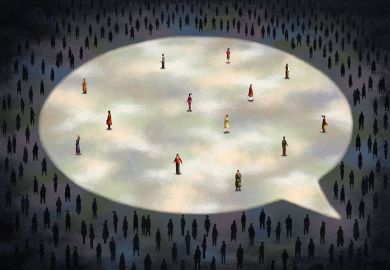A new study lifts the lid on Shakespearean biographies unencumbered by fact. Kiernan Ryan assays the genre
Frank Harris, author of The Man Shakespeare and His Tragic Life-Story (1909), once quipped in the Cafe Royal that although he was a stranger to the joys of homosexuality, "if Shakespeare asked me, I would have to submit". Actually, Harris did not doubt that Shakespeare had a predilection for the female of the species as pronounced as his own, but, like most biographers of the Bard before and since, he was free to play fast and loose with facts that were transparent fictions to begin with.
The real bare facts of Shakespeare's life are rehearsed with scrupulous circumspection by David Ellis in the first chapter of That Man Shakespeare .
They afford us, Ellis concludes, "more than enough to provide a broad sketch of his career, but almost nothing has survived which is relevant to his private life and can tell us about the nature and progress of his relationships or opinions". Ignorance has proved no impediment, however, to the throng of authors eager to peddle fresh lives of Shakespeare spun from pure speculation.
There will soon be a glut of Shakespeare biographies, all tricked out as the latest news of an author about whom nothing new has been discovered since the Mountjoy papers turned up in the year Harris's life appeared and pinpointed where Shakespeare once lodged in London. The recent spate of biographies by Park Honan, Anthony Holden, Katherine Duncan-Jones, Michael Wood and Stephen Greenblatt, whose blockbuster Will in the World showed how lucrative a well-hyped Bard bio could be, has not abated. The dust has scarcely settled on the kerfuffle caused by Will in the World , and already James Shapiro's 1599: A Year in the Life of William Shakespeare is bent on stealing its thunder. 1599 will shortly be elbowed aside in its turn by the biographies Peter Ackroyd and Bill Bryson are publishing this autumn.
Even gluttons for lives of Shakespeare seem to be doomed to indigestion. Fortunately, a potent antidote is now available in Ellis's splendid study of the myths made out of the man, from his time to our own, by literature, scholarship and biography. The sheer dearth of facts has spawned enduring legends, transmuting baseless anecdotes and scraps of gossip into solid suppositions and attested events.
There is not a jot of proof that the young Shakespeare fled Stratford for the London stage after being caught poaching Sir Thomas Lucy's deer. But, as Ellis observes, "the episode satisfied too many needs to be discarded", not least the idea of Shakespeare as "a literary Dick Whittington". So, like the rumour that the dramatist William Davenant was Shakespeare's illegitimate son, or the more scandalous report that Shakespeare "died a papist", it hardened into the core lore around which all later lives have been constructed.
That lore has fuelled centuries of scholarly feuds and inspired the quest to resurrect Shakespeare in novels, plays, poetry and films. Credit for the first fictional depiction of the dramatist goes to Dryden's Troilus and Cressida (1679), whose prologue is delivered by Shakespeare's ghost. Full reincarnation came much later with his seminal cameo in Walter Scott's Kenilworth (1821), and Shakespeare has played starring and supporting roles ever since - most recently in novels by Anthony Burgess and Robert Nye, in Edward Bond's Bingo and in John Madden's movie Shakespeare in Love .
The range of material Ellis surveys, much of it unfamiliar, is remarkable. With its wealth of extracts from inaccessible texts and astute illustrations, That Man Shakespeare is at once an original anthology crammed with potential research projects and an iconoclastic history of the ultimate cultural icon. But the book's pièce de résistance is the chapter in which Ellis blows the gaff on the ruses that modern biographers of Shakespeare use to disguise a blatant lack of information. It should be compulsory reading for anyone about to concoct yet another new life of Stratford's sole claim to fame.
The most outrageous ruse turns the absence of evidence into triumphant confirmation. Thus, in the looking-glass world of those convinced that Shakespeare was a closet papist, "it is precisely because Shakespeare never reveals he was a Catholic that we know he must have been one". Then there is what Ellis calls the "all-purpose tool" of the plays and the sonnets, which can be cited in support of whatever the biographer fancies, as when Duncan-Jones deduces from Troilus that Shakespeare was racked by syphilis. An equally indispensable method "for making a little, or even nothing, go a long way" is "the argument from proximity", which can magically link Shakespeare with glamorous figures - such as the Jesuit martyr Edmund Campion - who might have been in the same place at roughly the same time.
All these devices are on display in Shapiro's 1599 , buttressed throughout by those crucial mainstays of the craft - "surely", "probably" and "almost certainly". But the chief ploy to which Shapiro resorts is what Ellis dubs "history to the rescue". Its earliest exponent was Nathan Drake, whose Shakespeare and His Times (1817), Ellis notes, was the first biography of Shakespeare "to grasp fully the life-saving implications of the phrase 'and his times'". The danger this approach courts is that Shakespeare becomes a pretext for protracted historical digressions, whose bearing on the playwright and his work is tenuous at best.
One might think that Shapiro's bright idea of focusing on a single year of "Shakespeare at work" would avoid this danger and give us a real sense of how Henry V , Julius Caesar , As You Like It and Hamlet "emerged from an engagement with his times". But magnifying the moment makes the supposed connections between texts and context neither clearer nor more convincing.
On the contrary, the more detailed the historical background becomes, the harder it is to see what tethers these plays to it.
In the case of As You Like It , any attempt to anchor that enchanting jeu d'esprit in current events would be absurd, so Shapiro wisely throws the towel in at the start, claiming "its real topicality lies elsewhere, in its attentiveness to evolving notions of Elizabethan comedy and pastoral". Huge slabs of topical synopsis are wheeled on, however, to shore up the old idea that "the obsessive concerns of Elizabethan Irish policy run deep through Henry V ". Unfortunately for this thesis, as Shapiro disarmingly concedes, "for much of the play, allusions to the current crisis in Ireland are fleeting", and "only in the play's final act does Essex's imminent Irish campaign, long submerged, break the surface of the play" in an equally fleeting allusion by the chorus. That sly phrase "long submerged" is a perfect instance of what Ellis terms the "argument from absence".
The trouble with Shapiro's sharp focus on 1599 is that it forces him to contrive contemporary sources for the plays in order to demonstrate "the extent to which Shakespeare was always writing out of his own cultural moment". Hence Julius Caesar 's key concerns are seen as prompted by attempts to assassinate Elizabeth, the censorship of books and preachers, and the politicisation of public holidays. Hamlet 's opening scene must be charged with the fear of a second Armada that had recently gripped the nation, while the closet scene is alleged to originate in Essex's irate invasion of the bedchamber of his queen.
The thought that these plays owe less to extraneous factors than they do to Shakespeare's dramatic imagination and poetic power is naturally anathema to the historicist, since it renders all those hours in the archives redundant. So Shakespeare's revolutionising of the soliloquy in Hamlet must be shackled to the emergence of the essay as practised by Montaigne and Cornwallis, despite the fact that the former's essays appeared in English only in 1603, while the latter's were not published until 1600 and their influence on Hamlet was therefore, as Shapiro admits, "unlikely".
Yet even if that influence were undeniable, what difference would it make to our understanding of Hamlet? Suppose the closet scene was indeed a direct echo of Elizabeth and Essex: so what? Such circumstantial information is superfluous to a grasp of the tragedy, and only the distorted priorities of an antiquarian agenda could deceive anyone into believing otherwise.
The whole thrust of Shapiro's book is that 1599 was "the most decisive year" of Shakespeare's career, "the one in which he redefined himself and his theatre". But this contention requires further distortions of emphasis in order to be sustained. It requires us to regard the 18 plays Shakespeare had already written, including trailblazing masterpieces such as A Midsummer Night's Dream , Romeo and Juliet and Henry IV , as a long apprenticeship. And it banks everything on casting Hamlet as the breakthrough play in which Shakespeare "had at last found his own way forward".
In his epilogue, however, Shapiro is forced to throw this view into reverse: " Hamlet , in retrospect, faced backwards more than it looked forwards, marking the end of an era". For in the next three years, Shakespeare wrote only two plays, Twelfth Night and Troilus , the first dismissed by Shapiro as a "formulaic throwback to earlier Shakespearean comedy", the second "too unmoored and too bitter" to merit staging. So much for 1599 as the annus mirabilis that transfigured Shakespeare's art. A stronger case might have been made for the astonishing year in which he would later write King Lear , Macbeth and Antony and Cleopatra .
In his preface, Shapiro presents 1599 as a refutation of Coleridge's belief that Shakespeare wrote "exactly as if of another planet". If the book proves anything, however, it is the bankruptcy of approaches to Shakespeare that imprison his plays in their world and time and remain blind to their unfathomable strangeness.
Kiernan Ryan is professor of English, Royal Holloway, University of London.
1599: A Year in the Life of William Shakespeare
Author - James Shapiro
Publisher - Faber
Pages - 429
Price - £16.99
ISBN - 0 571 21480 0



